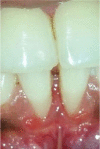Assessment of non-carious root surface defects in areas of gingival recession: A descriptive study
- PMID: 27703607
- PMCID: PMC5045686
- DOI: 10.4317/jced.52831
Assessment of non-carious root surface defects in areas of gingival recession: A descriptive study
Abstract
Background: The purpose of this descriptive study was to observe the distribution of four different classes of non-carious cervical root surface discrepancies in teeth with gingival recession. Additionally to explore the different treatment modalities in the literature for each of these defects.
Material and methods: A total of 150 subjects with at least one labial gingival recession were included in the study. 1400 teeth were evaluated using 2.5 X magnification loupes and UNC -15 probe for the presence of the cemento-enamel junction and step like defects according to Pini-Prato's classification: A-, identifiable CEJ without defect; A+, identifiable CEJ with defect; B-, unidentifiable CEJ without defect, B+, unidentifiable CEJ with defect. Further a comprehensive electronic and hand search of pubmed indexed journals was performed to identify appropriate treatment modalities for these defects and their predictability following restorative/surgical or combination of both.
Results: A total of 1400 teeth with exposed root surfaces were examined (793 Maxillary; 607 mandibular). 499 teeth were A-, 405 were A+, 322 were B+ and 174 were B-. The distribution of these defects in different teeth was: 36% premolars, 32% molars, 21% incisors and 11% canines, collectively 68% in the aesthetic zone.
Conclusions: Majority of these lesions are in the maxillary aesthetic zone. Hence the presence of the CEJ and the defect must be taken into account while managing these defects surgically. Key words:Cervical abrasion, gingival recession, magnification loupes, root coverage, step defects.
Conflict of interest statement
The authors declare that they have no conflict of interest.
Figures
References
-
- Loe H, Anerud A, Boysen H, Morrison E. Natural history of periodontal disease in man. Rapid, moderate and no loss of attachment in Sri Lankan labourers 14 to 46 years of age. J Clin Periodontol. 1986;13:431–45. - PubMed
-
- Smukler H, Landsberg J. The toothbrush and gingival traumatic injury. J Periodontol. 1984;55:713–9. - PubMed
-
- Dominiak M, Kalecińska E, Krzysztoń E, Dominiak P, Mierzwa-Dudek D, Sulka A. Correlation between temporomandibular dysfunction, disturbances of occlusion and gingival recession in a group of youth students. Bull Group Int Rech Sci Stomatol Odontol. 2006;47:40–6. - PubMed
-
- Kim DM, Neiva R. Periodontal soft tissue non-root coverage procedures: a systematic review from the AAP Regeneration Workshop. J Periodontol. 2015;86:S56–72. - PubMed
-
- Ward VJ. A clinical assessment of the use of the free gingival graft for correcting localized recession associated with frenal pull. J Periodontol. 1974;45:78–83. - PubMed
LinkOut - more resources
Full Text Sources
Other Literature Sources




